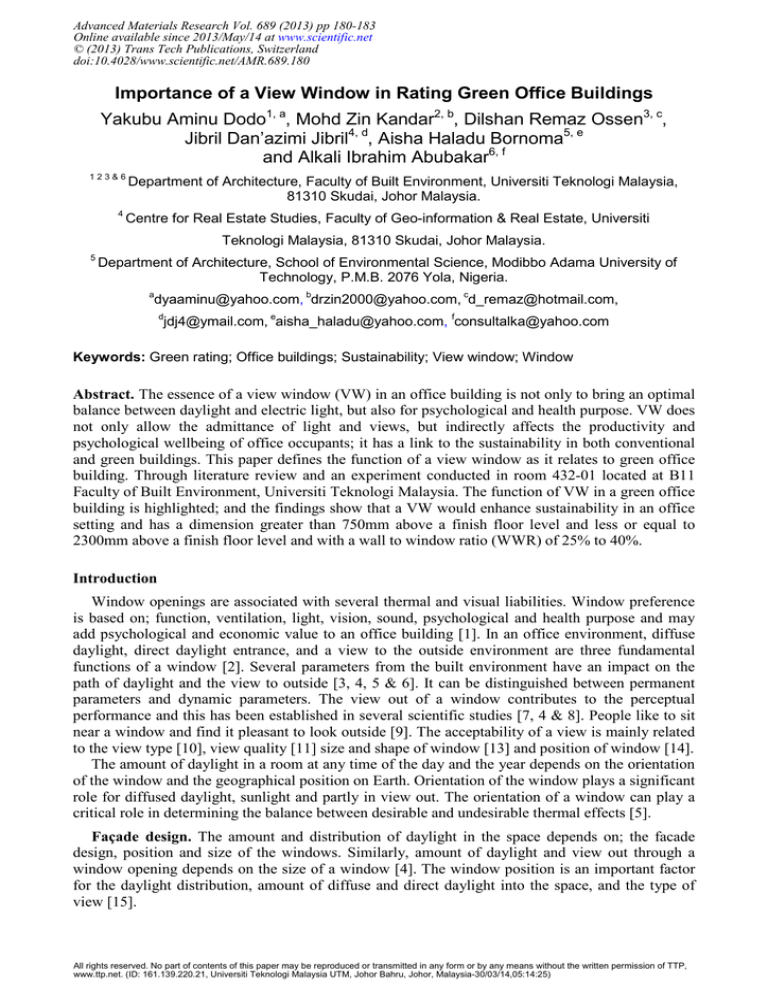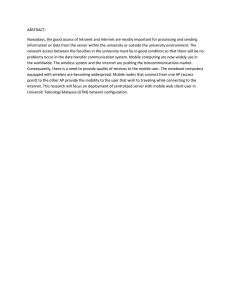
Advanced Materials Research Vol. 689 (2013) pp 180-183
Online available since 2013/May/14 at www.scientific.net
© (2013) Trans Tech Publications, Switzerland
doi:10.4028/www.scientific.net/AMR.689.180
Importance of a View Window in Rating Green Office Buildings
Yakubu Aminu Dodo1, a, Mohd Zin Kandar2, b, Dilshan Remaz Ossen3, c,
Jibril Dan’azimi Jibril4, d, Aisha Haladu Bornoma5, e
and Alkali Ibrahim Abubakar6, f
123&6
4
Department of Architecture, Faculty of Built Environment, Universiti Teknologi Malaysia,
81310 Skudai, Johor Malaysia.
Centre for Real Estate Studies, Faculty of Geo-information & Real Estate, Universiti
Teknologi Malaysia, 81310 Skudai, Johor Malaysia.
5
Department of Architecture, School of Environmental Science, Modibbo Adama University of
Technology, P.M.B. 2076 Yola, Nigeria.
a
dyaaminu@yahoo.com, bdrzin2000@yahoo.com, cd_remaz@hotmail.com,
d
jdj4@ymail.com, eaisha_haladu@yahoo.com, fconsultalka@yahoo.com
Keywords: Green rating; Office buildings; Sustainability; View window; Window
Abstract. The essence of a view window (VW) in an office building is not only to bring an optimal
balance between daylight and electric light, but also for psychological and health purpose. VW does
not only allow the admittance of light and views, but indirectly affects the productivity and
psychological wellbeing of office occupants; it has a link to the sustainability in both conventional
and green buildings. This paper defines the function of a view window as it relates to green office
building. Through literature review and an experiment conducted in room 432-01 located at B11
Faculty of Built Environment, Universiti Teknologi Malaysia. The function of VW in a green office
building is highlighted; and the findings show that a VW would enhance sustainability in an office
setting and has a dimension greater than 750mm above a finish floor level and less or equal to
2300mm above a finish floor level and with a wall to window ratio (WWR) of 25% to 40%.
Introduction
Window openings are associated with several thermal and visual liabilities. Window preference
is based on; function, ventilation, light, vision, sound, psychological and health purpose and may
add psychological and economic value to an office building [1]. In an office environment, diffuse
daylight, direct daylight entrance, and a view to the outside environment are three fundamental
functions of a window [2]. Several parameters from the built environment have an impact on the
path of daylight and the view to outside [3, 4, 5 & 6]. It can be distinguished between permanent
parameters and dynamic parameters. The view out of a window contributes to the perceptual
performance and this has been established in several scientific studies [7, 4 & 8]. People like to sit
near a window and find it pleasant to look outside [9]. The acceptability of a view is mainly related
to the view type [10], view quality [11] size and shape of window [13] and position of window [14].
The amount of daylight in a room at any time of the day and the year depends on the orientation
of the window and the geographical position on Earth. Orientation of the window plays a significant
role for diffused daylight, sunlight and partly in view out. The orientation of a window can play a
critical role in determining the balance between desirable and undesirable thermal effects [5].
Façade design. The amount and distribution of daylight in the space depends on; the facade
design, position and size of the windows. Similarly, amount of daylight and view out through a
window opening depends on the size of a window [4]. The window position is an important factor
for the daylight distribution, amount of diffuse and direct daylight into the space, and the type of
view [15].
All rights reserved. No part of contents of this paper may be reproduced or transmitted in any form or by any means without the written permission of TTP,
www.ttp.net. (ID: 161.139.220.21, Universiti Teknologi Malaysia UTM, Johor Bahru, Johor, Malaysia-30/03/14,05:14:25)
Advanced Materials Research Vol. 689
181
Window sizes and height. [13, 16], tried to investigate People preferences for view and window
sizes that leads to an optimum occupant’s satisfaction. The result shows that window distance and
height affected the subject’s judgements of acceptable size and satisfaction.
Method
The study was conducted through literature review, case studies and an experimental study of a
single occupant office room . After an extensive literature review, case studies of; a conventional
building, a retrofitted building as well as a green office building all located in Malaysia were
conducted. This was followed by an experimental study in room 432-01 located at B11 Faculty of
Built Environment, Universiti Teknologi Malaysia. The amount of lux received at various task areas
were measured with regard to the VW. An illuminance level of (300 to 400) lux was set as the
bench mark for determining the amount of daylit in each task area. Occupants were asked to
determine which part they would prefer to sit in the office in reference to the VW.
\
Fig.1. Rule of thumb for Fig.2. Plan of the experimental Fig.3. Axonometric view of the
penetration of daylight study to determine seating plan of the experimental study
from a VW
preference in relationship to a
VW
(Fig. 1) shows the daylight zone, source; [12], while (Fig. 2 and Fig. 3) shows the experimental
study carried out in office room 432-01 for a single occupant measured 2900mm by 4400mm by
3200mm located at B11, Faculty of Built Environment, Universiti Teknologi Malaysia: to
determine occupant’s perception on choice to seat in a location in relationship to a VW as a source
of daylight and view. Using the rule of thumb as shown in (Fig. 1) the VW height was determine as
1500mm multiply by (d) the height of the VW from the finished floor level which was 2100mm and
the result is 3150mm from the VW would be the day lighted zone.
Result and Discussion
Views are measured by drawing a line of sight from a location in the building to any exterior
windows; if the line of sight to the exterior window is unbroken, that location has a view. The line
of sight must be drawn at the appropriate height for occupants; for instance, typical office workers
or students are usually sitting, with eye level assumed to be 42" (1100mm) above finished floor
level. In order to be considered a view, the window must provide a reasonable vantage point outside
the building. From (Fig. 2 and Fig. 3), there is the tendency that occupants sat close to the view
window due to higher lux level recorded within the VW zone as the distance from the view window
to the task area increase the availability of daylight decrease. Most of the occupants prefer to sit
near the VW, which is the window located opposite the door in (Fig. 2). The size of a window
determines how much light comes into a room, but the position and shape of a window decides the
182
Green Building Technologies and Materials II
light distribution in a room and which part of the external environment can be seen (ground,
landscape, and/or the sky). An opening in the upper part of the facade provides deep daylight
entrance into the space. The spatial daylight distribution is also better when the window is placed in
the upper part of the wall. However, a window positioned at the bottom or middle part of the façade
provides a lower daylight level, but creates a better line of sight to view outside.
Defining a view window. One rule of thumb considers VWs ("vision glazing") to be any glazing
above 30" (750mm) and below 90" (2300mm) from the finished floor in a room. Skylights and very
high windows don’t count and the WWR should be around 25% to 40%. Skylight and very high
windows do not count in defining a VW as exemplified in (Fig. 4).
Fig.4. Diagrammatical representation of the definition of a VW in a room setting
Furthermore, other findings demonstrate the importance of lighting quality for productivity. Given
that costs for people’s salaries and benefits are typically 100 times a building’s energy costs, even a
small gain in productivity can be the equivalent of paying the energy bill several times over [17].
Summary
Sitting close to a VW can be psychologically and physiologically beneficial, especially if the view
contains natural features [3]. Visual contact with nature through windows reduced employees’
stress and promotes their quality of life by providing them with restorative experiences. In addition,
rating green office buildings be it new constructions or retrofitting existing ones, the choice of
appropriate view window would enhance sustainability as the right size of opening would be
designed. The required amount of lux level occupants in an office space required to perform various
tasks would be generated and a healthy and comfortable environment that saves energy would be
achieve base on a region required amount of lux level.
Acknowledgements
The authors would like to acknowledge and thank the International Doctorial Fellowship (IDF)
UTM and The Educational Trust Fund (ETF) Nigeria for contributing to this research.
Advanced Materials Research Vol. 689
183
References
[1] K. M. J. farley and J. A. Veitch, “A room with a view: a review of the effects of windows on
work and Well-being,” IRC 136, 2001.
[2] J. H. Heerwagen and G. H. Orians, “Adaptations to Windowlessness: A study of the use of
visual decor in windowed and windowless offices. Environment and Behaviour,” environment and
behaviour, vol. 18, no. 5, pp. 623–639, 1986.
[3] E. Ne’eman and R. G. Hopkinson, “Critical minimum acceptable window size: a study of
window design and provision of view,” Lighting Research and Technology, vol. 2, pp. 17–27, 1970.
[4] J. Diepens, F. Bakker, and L. Zonneveldt, Daylight design variations book. TNO-TUE Centre
for Building Research, 2000.
[5] L. Sims, “Enhance Users Satisfaction, Performance with Day lighting,” Research and
development, 2002.
[6] J. Yuldelson, Green building A to Z; Understanding the language of green building. New society
publisher Canada, 2007.
[7] P. R. Boyce, Human Factors in Lighting, Second. CRC Press, 2003.
[8] N. Wang and M. Boubekri, “Investigation of declared seating preference and measured
cognitive performance in a sunlit room,” Journal of Environmental Psychology, vol. 30, no. 2, pp.
226–238, Jun. 2010.
[9] A. D. Galasiu and J. Veitch, “Occupant’s preference and satisfaction with the luminous
environment and control systems in day lit offices: a literature review,” Energy and Building, vol.
38, pp. 728–742, 2006.
[10] P. R. Boyce, C. Hunter, and H. Howlett, “The benefits of daylight through windows,”
Reusselaer Polytechnic institute. Troy NY, Lighting Research Centre, Research DE-FC2602NT41497, Sep. 2003.
[11] T. A. Markus, “The function of windows – A reappraisal,” Building Science, vol. 2, pp. 97–
121, 1967.
[12] J. O’Connor, E. Lee, F. Rubistein, and S. Selkowitz, “Tips for Daylight with Windows: The
Integrated Approach,” University of California, Earnest Orlando Lawrence Berkeley National
laboratory, LBNL-39945, 1997.
[13] K. Dijkstra, “Understanding healing environments: effects of physical environmental stimuli
on patients’ health and well-being,” University of Twente,, Netherlands, 2009.
[14] E. C. Keighly, “Visual requirements and reduced fenestration in office buildings- a study of
window shape,” Building science, vol. 8, pp. 311–320, 1973.
[15] J. Christoffersen, K. Johnsen, E. Petersen, O. Valbjorn, and S. Hygge, “Windows and Daylight
– A post-occupancy evaluation of Danish offices, in Lighting 200,” in CIBSE/ILE Joint Conference
University of New York, UK: CIBSE, 2000, pp. 112–120.
[16] B. L. Collins, “Windows and people, a literature survey. Psychological reaction to
environments with and without windows.” National bureau of standards, 1975.
[17] M. B. C. Aries, J. A. Veitch, and G. R. Newsham, “Windows, view, and office characteristics
predict physical and psychological discomfort,” Environmental Psychology, pp. 1–9, 2010.
Green Building Technologies and Materials II
10.4028/www.scientific.net/AMR.689
Importance of a View Window in Rating Green Office Buildings
10.4028/www.scientific.net/AMR.689.180





